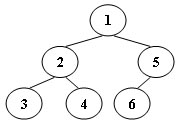标签:for lex item 元素 order osi justify exactly bin
An inorder binary tree traversal can be implemented in a non-recursive way with a stack. For example, suppose that when a 6-node binary tree (with the keys numbered from 1 to 6) is traversed, the stack operations are: push(1); push(2); push(3); pop(); pop(); push(4); pop(); pop(); push(5); push(6); pop(); pop(). Then a unique binary tree (shown in Figure 1) can be generated from this sequence of operations. Your task is to give the postorder traversal sequence of this tree.

Each input file contains one test case. For each case, the first line contains a positive integer N (≤) which is the total number of nodes in a tree (and hence the nodes are numbered from 1 to N). Then 2 lines follow, each describes a stack operation in the format: "Push X" where X is the index of the node being pushed onto the stack; or "Pop" meaning to pop one node from the stack.
For each test case, print the postorder traversal sequence of the corresponding tree in one line. A solution is guaranteed to exist. All the numbers must be separated by exactly one space, and there must be no extra space at the end of the line.
6
Push 1
Push 2
Push 3
Pop
Pop
Push 4
Pop
Pop
Push 5
Push 6
Pop
Pop3 4 2 6 5 1
#include <cstdio> #include <cstdlib> #include <cstring> #include <iostream> #include <stack> using namespace std; typedef int elemType; typedef struct BTreeNode{ elemType data; int flag; struct BTreeNode *lchild, *rchild; }*Bitree; stack<Bitree> bst; Bitree tempNode = NULL; int printflag=1; void popNode(){ tempNode = bst.top(); bst.pop(); } void pushNode1(elemType udata){ Bitree T; T=(Bitree)malloc(sizeof(BTreeNode)); T->data = udata; bst.top()->lchild=T; bst.push(T); T->lchild = NULL; T->rchild = NULL; } void pushNode2(elemType udata){ Bitree T; T=(Bitree)malloc(sizeof(BTreeNode)); T->data = udata; tempNode->rchild=T; bst.push(T); T->lchild = NULL; T->rchild = NULL; } void initTree(Bitree &T, elemType udata){ T=(Bitree)malloc(sizeof(BTreeNode)); T->data = udata; bst.push(T); T->lchild = NULL; T->rchild = NULL; } void pri(Bitree T){ if(T){ pri(T->lchild); pri(T->rchild); if(printflag){ printflag = 0; cout << T->data; }else{ cout << " " << T->data; } } } int main() { int status=-1, udata, n; char opin[20]; Bitree T; //-1 初态 //1 push之后push,在顶的左边 //2 pop之后push,在pop出的元素右边 cin >> n; for(int i=0; i<2*n; i++){ cin >> opin; if(!strcmp(opin, "Push")){ cin >> udata; if(status == -1) initTree(T, udata); else if(status == 1) pushNode1(udata); else if(status == 2) pushNode2(udata); status = 1; }else if(!strcmp(opin, "Pop")){ popNode(); status = 2; } } pri(T); //cout << "Hello world!" << endl; return 0; }
标签:for lex item 元素 order osi justify exactly bin
原文地址:https://www.cnblogs.com/wstnl/p/14702647.html